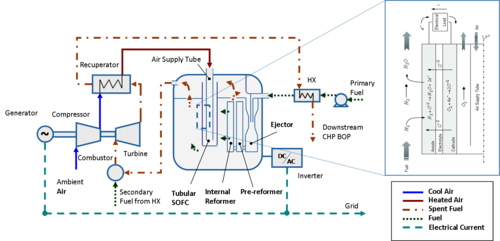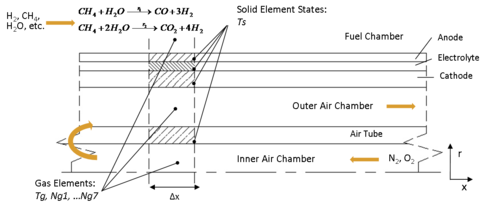Solid Oxide Fuel Cell
A solid oxide fuel cell (SOFC) is an electrochemical energy conversion device that produces electricity directly from oxidizing a fuel. Fuel cells are characterized by their charge transfer mechanism; the SOFC has a solid oxide electrode-electrolyte assembly. Advantages of this class of fuel cells include high efficiency, long-term stability, fuel flexibility, low emissions, and relatively lower catalyst cost. The largest challenge is preserving oxide integrity and fuel cell lifetime due to mechanical and chemical compatibility issues. Also, the high operating temperature can increase startup times but also provides benefits of internal reforming and waste heat which can be utilized downstream.
The objective of the SOFC model is to investigate advanced process control to maintain performance and operational integrity subject to load-following, efficiency maximization, and disturbances.

The distributed parameter approach produces a large number of states: 220 states for 10 finite volumes in the axial direction. The model is expressed as a collection of differential and algebraic equations that are solved simultaneously, without algebraic loops. With APMonitor modeling language, the algebraic equations are expressed in an implicit form. The model contains many nonlinearities which are introduced by reaction and electrochemical terms and temperature dependent properties.

One of the solution challenges is that multiple time scales of a significantly different magnitude. This creates a stiff problem unless steady-state or quasi-steady-state assumptions are considered. For example, electrical changes occur in milli-seconds, chemical changes occur in a few seconds, and thermal changes occur in minutes or hours.
Model results are consistent with other research publications and experimental validation.
Reference
B.J. Spivey and T.F. Edgar, Dynamic Modeling of Reliability Indicators in Solid Oxide Fuel Cells and Implications for Advanced Control, AIChE Fall 2010 Annual Meeting, Salt Lake City, Utah, November 2010. Presentation (PDF)
See also SOFC Research